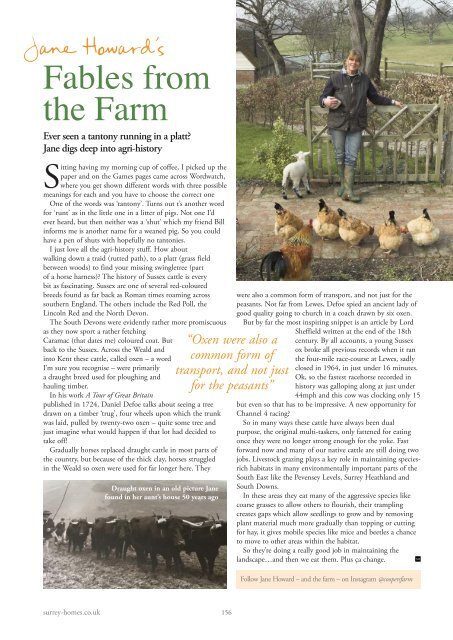Surrey Homes | SH49 | November 2018 | Gift supplement inside
The lifestyle magazine for Surrey - Inspirational Interiors, Fabulous Fashion, Delicious Dishes
The lifestyle magazine for Surrey - Inspirational Interiors, Fabulous Fashion, Delicious Dishes
You also want an ePaper? Increase the reach of your titles
YUMPU automatically turns print PDFs into web optimized ePapers that Google loves.
Jane Howard’s<br />
Fables from<br />
the Farm<br />
Ever seen a tantony running in a platt?<br />
Jane digs deep into agri-history<br />
Sitting having my morning cup of coffee, I picked up the<br />
paper and on the Games pages came across Wordwatch,<br />
where you get shown different words with three possible<br />
meanings for each and you have to choose the correct one<br />
One of the words was ‘tantony’. Turns out t’s another word<br />
for ‘runt’ as in the little one in a litter of pigs. Not one I’d<br />
ever heard, but then neither was a ‘shut’ which my friend Bill<br />
informs me is another name for a weaned pig. So you could<br />
have a pen of shuts with hopefully no tantonies.<br />
I just love all the agri-history stuff. How about<br />
walking down a traid (rutted path), to a platt (grass field<br />
between woods) to find your missing swingletree (part<br />
of a horse harness)? The history of Sussex cattle is every<br />
bit as fascinating. Sussex are one of several red-coloured<br />
breeds found as far back as Roman times roaming across<br />
southern England. The others include the Red Poll, the<br />
Lincoln Red and the North Devon.<br />
The South Devons were evidently rather more promiscuous<br />
as they now sport a rather fetching<br />
Caramac (that dates me) coloured coat. But<br />
back to the Sussex. Across the Weald and<br />
into Kent these cattle, called oxen – a word<br />
I’m sure you recognise – were primarily<br />
a draught breed used for ploughing and<br />
hauling timber.<br />
In his work A Tour of Great Britain<br />
published in 1724, Daniel Defoe talks about seeing a tree<br />
drawn on a timber ‘trug’, four wheels upon which the trunk<br />
was laid, pulled by twenty-two oxen – quite some tree and<br />
just imagine what would happen if that lot had decided to<br />
take off!<br />
Gradually horses replaced draught cattle in most parts of<br />
the country, but because of the thick clay, horses struggled<br />
in the Weald so oxen were used for far longer here. They<br />
Draught oxen in an old picture Jane<br />
found in her aunt’s house 50 years ago<br />
“Oxen were also a<br />
common form of<br />
transport, and not just<br />
for the peasants”<br />
were also a common form of transport, and not just for the<br />
peasants. Not far from Lewes, Defoe spied an ancient lady of<br />
good quality going to church in a coach drawn by six oxen.<br />
But by far the most inspiring snippet is an article by Lord<br />
Sheffield written at the end of the 18th<br />
century. By all accounts, a young Sussex<br />
ox broke all previous records when it ran<br />
the four-mile race-course at Lewes, sadly<br />
closed in 1964, in just under 16 minutes.<br />
Ok, so the fastest racehorse recorded in<br />
history was galloping along at just under<br />
44mph and this cow was clocking only 15<br />
but even so that has to be impressive. A new opportunity for<br />
Channel 4 racing?<br />
So in many ways these cattle have always been dual<br />
purpose, the original multi-taskers, only fattened for eating<br />
once they were no longer strong enough for the yoke. Fast<br />
forward now and many of our native cattle are still doing two<br />
jobs. Livestock grazing plays a key role in maintaining speciesrich<br />
habitats in many environmentally important parts of the<br />
South East like the Pevensey Levels, <strong>Surrey</strong> Heathland and<br />
South Downs.<br />
In these areas they eat many of the aggressive species like<br />
coarse grasses to allow others to flourish, their trampling<br />
creates gaps which allow seedlings to grow and by removing<br />
plant material much more gradually than topping or cutting<br />
for hay, it gives mobile species like mice and beetles a chance<br />
to move to other areas within the habitat.<br />
So they’re doing a really good job in maintaining the<br />
landscape…and then we eat them. Plus ça change.<br />
Follow Jane Howard – and the farm – on Instagram @coopersfarm<br />
surrey-homes.co.uk<br />
156


















